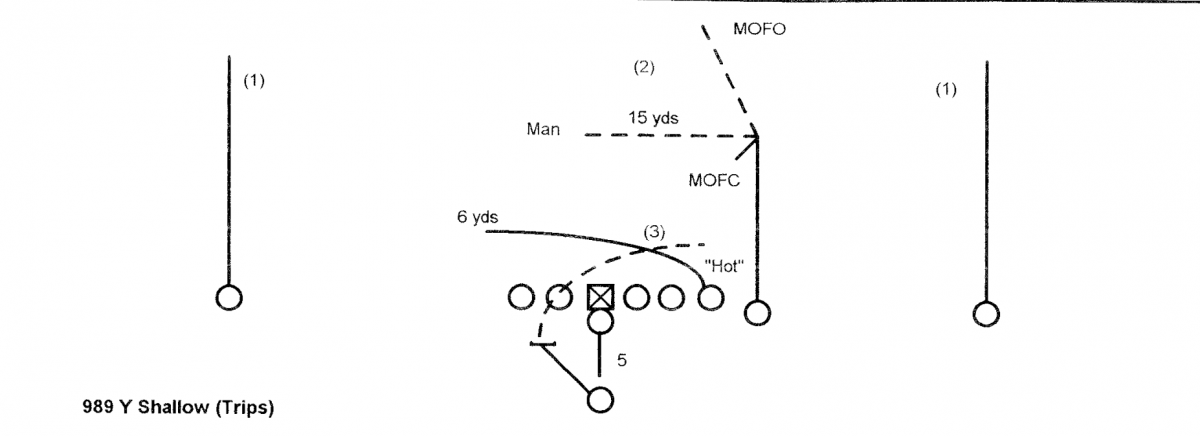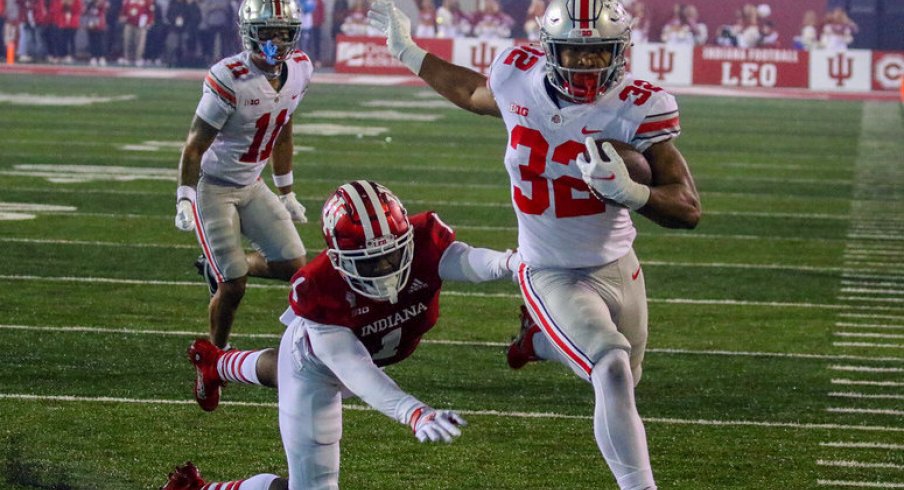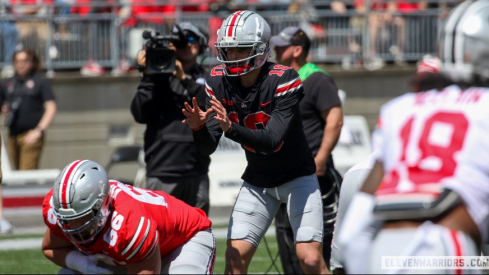Throughout the offseason, we here at Film Study spent a great deal of time previewing some of the bigger schematic challenges on Ohio State's 2021 schedule. Throughout the first half of the season, many of those predictions looked prophetic.
Minnesota proved capable of running the ball on the Buckeyes in week one, Joe Moorhead lit up the OSU defense in week two, and Tulsa hung around far longer than anyone liked in week three. The next opponent we previewed was the Indiana Hoosiers, and their modern, multiple defense, which had catapulted the program to prominence in 2020 and expected to give Ohio State fits this fall.
That prediction didn't hold up as well, I'm regret to report.
Ohio State obliterated Indiana on Saturday night, 54-7. The game was over by halftime as C.J. Stroud and the Buckeye offense found the end zone on seven of their first eight possessions, finishing the night with 539 yards of total offense.
The effort was made easier when Indiana was forced to play its third and fourth-string quarterbacks, neither of whom looked prepared for primetime. But when Ryan Day's team got the ball back, it wasn't as if they were simply calling plays at random.
Rather, Day and his staff had put together a clever game plan that left the Hoosiers struggling to identify their keys. After showing a variety of formations and personnel groups in the weeks prior, the Buckeyes spent much of the evening in the same, static pre-snap look with two receivers and a tight end to one side and the running back lined up behind Stroud in a 'Pistol' alignment.
The Buckeyes would often rush to the line of scrimmage in this formation and snap the ball quickly, leaving the Hoosiers with little time to make any adjustments to their complex defense. The result was often wide-open running lanes for OSU backs TreVeyon Henderson and Miyan Williams.
With the tight end lined up off the line, he could come back across the formation to seal the backside edge on the split-zone (aka Crunch) run seen here. Not only does Ruckert seal off the defensive end (#99) in the example above, but the safety responsible for covering him on a pass (#4) completely abandons his own run responsibility, leaving a wide-open hole for Williams.
The concept was on display all night, helping the Buckeyes roll up 187 yards on the ground. But Day and coordinator Kevin Wilson mixed it with normal zone runs from the same formation, leaving the Hoosiers on their heels trying to diagnose where the runner was headed.
Against a back as talented as Henderson, defenders can't play so hesitantly, as he's capable of going around, through, or over a tackler lacking conviction.
But it's hard to blame the Hoosiers for being cautious. The Buckeyes layered their game plan with a number of concepts that all looked identical before the snap, leaving the Hoosiers to react rather than attempt to dictate the pace of the game.
In addition to a number of runs from that 3x1 set, the Buckeyes also used Jeremy Ruckert as a receiver off play-action. With eight defenders playing run, the free safety (#1) is forced to make a play on the athletic tight end all the way in the flat, long after he'd already picked up a first down.
This ability to keep defenses on their heels is not new for Day and Wilson.
“We want to have a play-action off of all of our runs," Day told a group of high school coaches at a clinic in the spring of 2019. "So all the run [concepts] you saw early on, they should have some sort of play-action. If you have a run that doesn’t have a play-action, then it’s not married up right. In a perfect world, you’d like to have a run, a play-action, and then a screen off that run as well."
The same approach was applied to the Buckeyes' dropback passing game, as well. After torching Maryland two weeks ago with Four Verticals, Day relied upon a slightly different concept against the Hoosiers' two-deep coverage shells.
Known as 989, the concept originated from Don Coryell, the legendary former San Diego Chargers head coach who is the only man who can match Bill Walsh in terms of impact on the modern passing game. Dan Fouts and Kellen Winslow racked up thousands of yards with this concept, as the talented tight end would find the soft spot in the middle of the field between zone defenders, trusting his hall of fame quarterback to fire it into a small window.

That middle post pattern (called an 8 on Coryell's route tree) requires both the quarterback and receiver to read the defense the same way, bending the route toward wherever there is open grass. That kind of connection was on display when Stroud threw as beautiful a pass as you'll see from a college passer to Jaxson Smith-Njigba on the Buckeyes' second drive of the night.
989 is very common in today's game and was a staple of LSU's record-setting offense in 2019. Today, Bengals fans will likely recognize it as Joe Burrow and JaMarr Chase continue to run the play regularly in Cincinnati.
The Bengals opened up Thursday night with a favorite play of Joe Burrow when he was at LSU: the 989 concept.
— Nate Tice (@Nate_Tice) September 19, 2020
It's a simple but sound concept, Go's on the outside and a middle read Dig-Bender route by the slot.
Here's it being run Thursday by CIN and by LSU last year. pic.twitter.com/8rpD0OdGAB
As you can see, Burrow and Chase do most of their work on the outside, attacking cornerbacks one-on-one as the safeties look to take away the middle bender route. With talented receivers like Chris Olave and Garrett Wilson manning those positions for Ohio State, it's no wonder that Indiana's corners chose to play very soft coverage over the top.
However, Day and receivers coach Brian Hartline had prepared their stars for such treatment and added a subtle adjustment. When the receiver saw the corner giving such a cushion, he simply adapted his deep, vertical route into a comeback, giving Stroud a wide-open target on the numbers.
Once the Buckeyes had hit the deep comeback in this concept, then it was time for the coup de grâce: a double-move that left the Hoosier cornerback completely turned around.
Stroud has been magnificent for the Buckeyes as of late, but this was surely a throw he wishes he could have back. Ohio State would score a few plays later, but Stroud had his All-American receiver in the end zone if only he had put a little more behind this pass.
But such focus on the little things is what led to such a dominant win.
“Really, it’s just a matter of going out there every single day in practice and trying to execute at a high level, being really hard on ourselves,” Day said after the game. “Our standard is hard. If we don’t complete a pass or if we miss a protection or something like that, we’re hard on ourselves.”
There was little to critique in this performance, however. The Buckeyes had had an excellent game plan and executed it almost flawlessly, making anyone who predicted otherwise look downright foolish.



